What Are Payroll Deductions and How to Calculate Them Accurately?

Understanding what are payroll deductions is a headache for many businesses, especially when mistakes can lead to fines or unhappy employees. From taxes to benefit contributions, the rules can feel overwhelming. In this guide, MOR Software will break down the basics of payroll deduction meaning and show you how to calculate them accurately.
What Are Payroll Deductions?
What are payroll deductions? In simple terms, they are amounts taken from an employee’s gross wages to cover required or approved payments. These deductions explain the gap between total earnings and the net amount that employees actually take home. Common items withheld include:
- Federal and state income tax
- Social Security contributions
- Retirement savings, such as 401(k) plans
- Court-ordered wage garnishments
- Child support obligations
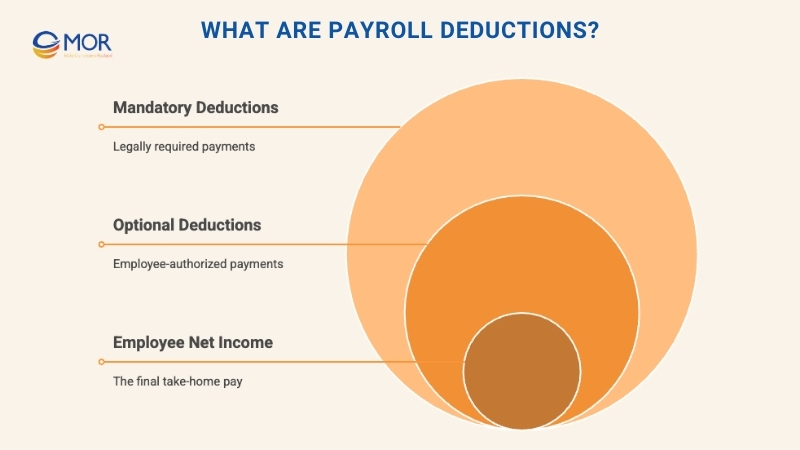
Some employee paycheck stubs are optional and may occur on a pretax or post-tax basis if the worker signs an authorization form. Examples include health insurance or retirement contributions.
In March 2024, the U.S. Bureau of Labor Statistics reported that 72% of private-industry workers had access to a workplace retirement plan. And 53% participated, so deductions tied to retirement plans appear on many paychecks.
For health coverage specifically, the 2024 KFF Employer Health Benefits Survey found that workers contributed an average of 6,296 dollars toward family coverage, typically via payroll deductions.
Others, like taxes and wage garnishments, are mandatory. Employers must calculate them correctly, since failing to withhold the right amount can make the business responsible for unpaid sums.
This explains the payroll deduction meaning and shows how it directly shapes the difference between gross and net pay.
How Do Payroll Deductions Work?
What are the payroll deductions in practice? They are handled every pay cycle, following federal, state, or court requirements. Employers can run the numbers by hand or rely on an automated payroll system that automates calculations.
Many companies prefer automation, since it lowers mistakes and guarantees that money reaches the right tax agencies or courts on time. In FY 2023, 70% of all child support collections were obtained through income withholding from paychecks. This shows how central employer processing is to court-ordered deductions.
The exact amount taken from each paycheck depends on multiple factors. Details on the employee’s Form W-4, state or local withholding certificates, chosen benefits, and any court-ordered deduction payroll items all come into play.
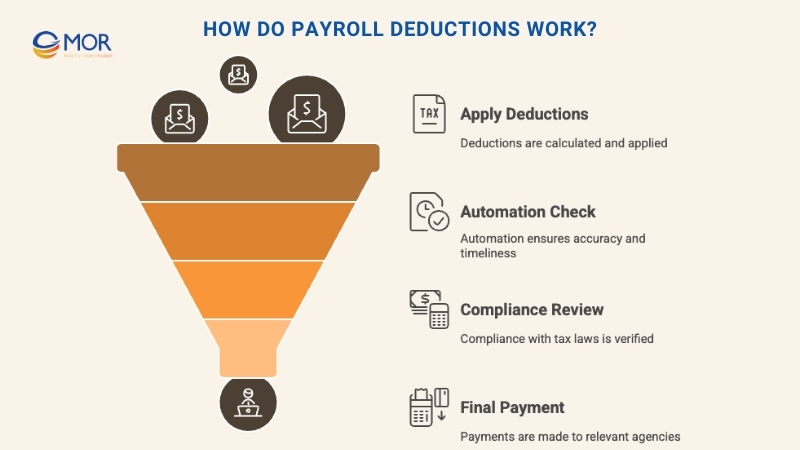
For example, someone enrolled in the company’s health plan will see those costs deducted, while another may have garnishments that must be withheld.
Location also matters. Where a business operates and where its staff members provide services affect deductions, since not every state requires income tax. In 2025, nine states don’t have a state income tax, so employees there have different state withholding rules.
This makes understanding what are deductions on a paycheck vital for accurate record keeping and compliance.
>>> READ MORE: Online Paycheck Generator: Benefits, Free Tools & Simple Guide
Main Types Of Payroll Deductions
Understanding what are payroll deductions isn’t complete without knowing the categories they fall into. Below, we’ve broken down the main types so you can see how each affects employee pay and compliance.
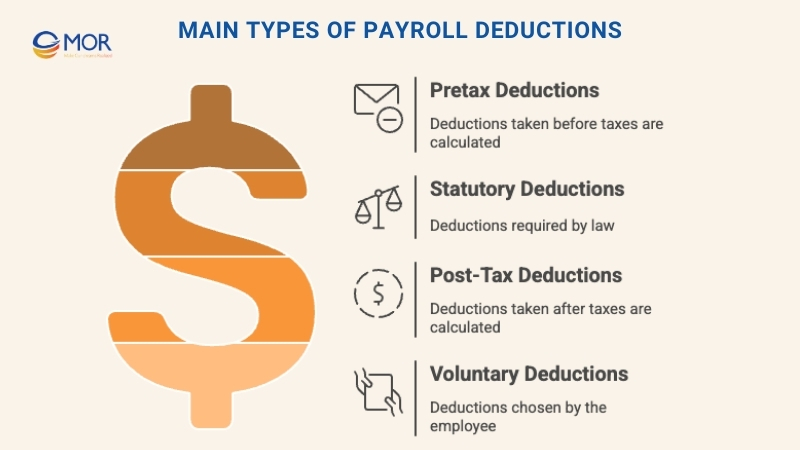
Pretax Deductions
Pretax deductions come out of an employee’s pay before taxes are applied. Since these amounts are removed from gross wages first, they reduce taxable income and, in turn, the tax bill owed to the government. They also help lower required payments for programs like the Federal Unemployment Tax (FUTA) and state unemployment insurance.
Common pretax deductions for payslip include health insurance premiums, retirement contributions, and group-term life insurance.
Participation is optional, but many employees choose it because pretax contributions usually cost less than paying for the same benefits after taxes. These deductions directly shape the payroll meaning for both employers and workers.
There are limits, though. Federal rules set annual contribution caps on certain pretax benefits. For example, the IRS places a maximum on how much an employee can defer each year into a 401(k) retirement plan. Staying within these caps is necessary to keep the pretax advantage.
Statutory Deductions
Statutory deductions are required by law and fund government programs. They cover federal income tax, state income tax, and the Federal Insurance Contributions Act (FICA) tax, which supports Medicare and Social Security. To calculate them correctly, employers must confirm each worker’s employment classification.
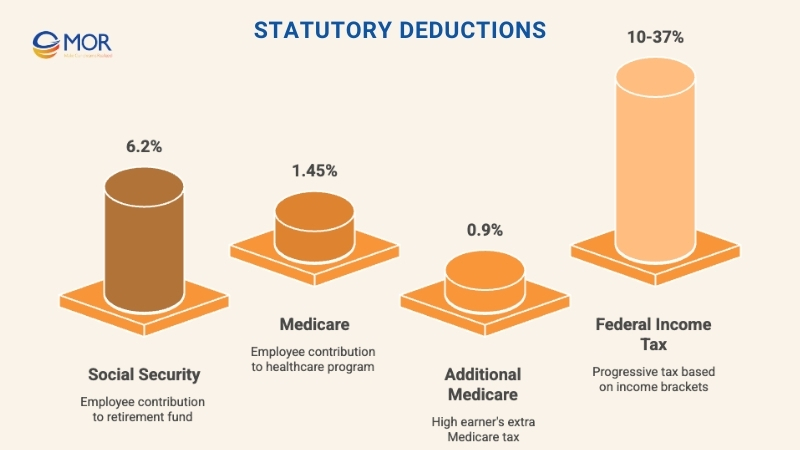
For independent contractors, you typically don’t withhold income tax, Social Security, or Medicare, since contractors pay self-employment tax themselves. In contrast, when the worker is classified as a direct employee, you must withhold and submit the proper taxes.
If there’s uncertainty about classification, employers can request guidance by filing Form SS-8 with the IRS. These rules highlight how employer taxes connect directly to lawful deductions for payroll.
FICA Taxes
FICA taxes cover contributions to Social Security and Medicare. Each employee pays 6.2% toward Social Security, up to the annual wage limit, and 1.45% for Medicare with no cap.
Together, this makes 7.65% taken out of every paycheck until the Social Security wage base is reached. Employers are legally required to match this same amount, making FICA a shared responsibility.
High earners may also owe the Additional Medicare tax. Once wages go above $200,000 in a year, an extra 0.9% must be withheld from that point forward. This extra amount can also apply to certain railroad retirement income or self-employment earnings.
Unlike standard FICA, employers don’t have to match this deduction payroll item. This is a key part of the broader payroll management system that keeps public programs funded.
Federal Income Tax
The federal income tax system uses seven brackets, starting at 10% and reaching up to 37%. These rates are progressive, so employee wages are taxed in layers. Income is first charged at the lowest rate, then moves upward through higher brackets until the full gross income amount is covered.
The exact taxable income ranges in each bracket depend on filing status, such as single, married filing jointly, married filing separately, or head of household, all of which are listed on Form W-4. Each year, the IRS adjusts these thresholds for inflation, which can shift where employees fall.
When it comes to withholding, employers typically use either the wage bracket method or the percentage method. Both options are explained in IRS Publication 15-T and guide employers in applying this core part of employee deductions during each pay cycle.
State and Local Taxes
Rules for state income tax differ across the country. A number of states use a flat rate on all income, some apply multiple tax brackets, and a handful collect no income tax at all. Certain states even align with the federal tax code rather than setting their own. Because of this variety, employers must review the laws in every state where staff members work to keep paid payroll in full compliance with local requirements.
Post-Tax Deductions
Post-tax deductions come out of wages after all mandatory taxes are withheld. Since they are taken from net pay instead of gross pay, they don’t lower taxable income.
Examples include Roth IRA contributions, disability insurance premiums, union dues, charitable donations, and court-ordered payments. Employees may opt out of most post-tax items, but wage garnishments are not optional. These deductions are an important part of understanding the full payroll deduction meaning for employees.
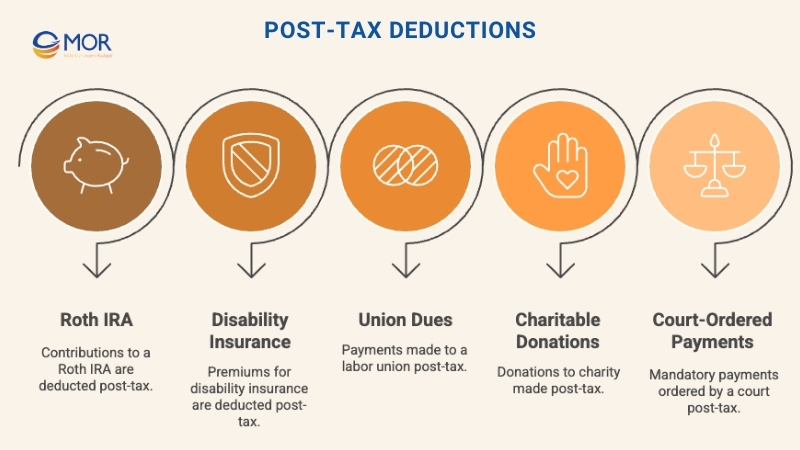
Wage Garnishments
A court, government agency, or the IRS can order you to withhold part of an employee’s net wages to repay debts like unpaid taxes, child support, alimony, or defaulted loans. Garnishment can apply to:
- Hourly pay
- Salaries
- Commissions
- Bonuses
- Pension or retirement plan payments
Each garnishment order will state the exact amount or percentage to withhold and where the funds should be sent. Employers must review these documents closely. Errors in calculation or failure to send payment may leave the business liable for unpaid amounts.
On top of the order itself, employers must also comply with Title III of the Consumer Credit Protection Act (CCPA). This law sets limits on how much of an employee’s wages can be garnished in a week and protects employees from being terminated solely because of a single garnishment.
This highlights why accurate handling of such deductions for payroll is so important.
Voluntary Deductions
Voluntary deductions are amounts employees agree to have withheld from their paychecks to cover benefits or other services. These can be taken out on a pretax basis under Section 125 of the Internal Revenue Code, or after tax depending on the type of benefit.
Since these deductions are optional, employers must be clear and transparent. Always obtain written consent before deducting insurance premiums, retirement contributions, or similar items.
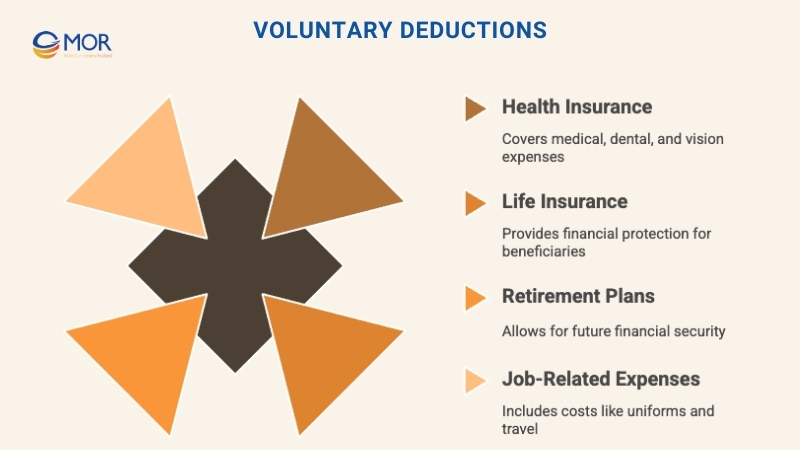
Each pay statement should show both the current deduction and the year-to-date total. Accurate records are critical, and in many states this reporting is required by law.
Common types of voluntary deduction payroll include:
Health Insurance
Providing medical, dental, and vision coverage helps employers attract and keep skilled staff. To avoid the expense becoming a burden, many businesses handle premiums on a pretax basis. Doing so is often more cost-effective for both employer and employee, but the IRS requires that contributions follow a Section 125 plan if taken before taxes.
Group-Term Life Insurance
Many employers provide basic term life insurance at no cost to employees, often up to $50,000 of coverage. Any amount above that threshold is treated as taxable income.
When employees choose to add extra coverage or extend policies to their dependents, the additional premium is normally withheld from pay on a post-tax basis. These arrangements fall under voluntary deductions for payroll and must be recorded clearly on pay statements.
Retirement Plans
Retirement savings plans are another common form of employee deductions. Among the most popular are 401(k) plans and Roth IRAs. Contributions to a 401(k) are exempt from federal and most state income taxes but remain subject to FICA taxes.
By contrast, Roth IRA contributions are deducted after tax, meaning employees pay taxes upfront but enjoy tax-free withdrawals in retirement. Both options play an important role in long-term financial planning.
Job-Related Expenses
Union employees often see deductions for membership fees along with any taxable benefits provided by the union. Other common work-related costs that may appear in payroll include uniforms, meal plans, and travel expenses.
Still, not every state permits these types of withholdings, so employers need to check local laws before applying such deduction payroll items.
>>> READ MORE: How To Calculate YTD In Payslip? A Simple Guide For 2025
Payroll Deduction Authorization Form
Employers may use IRS Form 2159, Payroll Deduction Agreement, when an employee owes back taxes. This document notifies the IRS that a portion of the employee’s wages will be withheld and sent directly to the government.
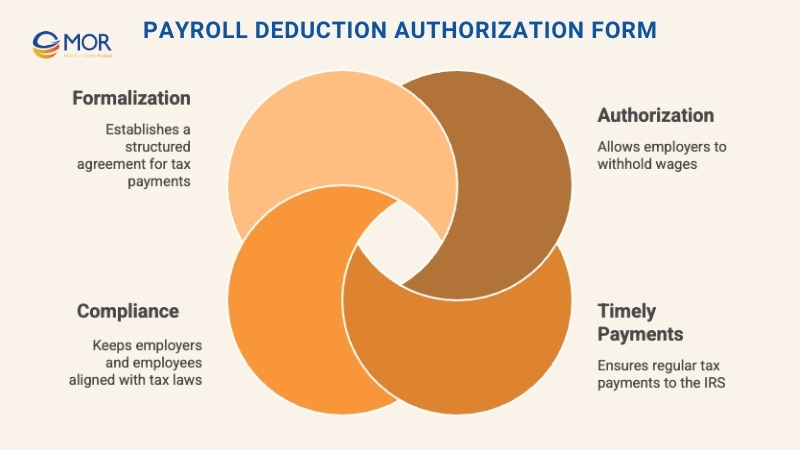
It also confirms the payment schedule, ensuring that the employer submits funds on time and in line with the agreed frequency. This process formalizes the arrangement and keeps both parties compliant with federal payroll tax requirements.
How to Calculate Payroll Deductions?
The process of calculating what are payroll deductions means converting an employee’s gross pay into their final net pay. Employers usually follow these steps:
- Subtract pretax contributions, such as health insurance premiums, 401(k) savings, and other approved voluntary benefits.
- Use the employee’s Form W-4 and the IRS tax tables to determine the correct federal income tax withholding.
- Deduct 7.65% of adjusted wages for Social Security and Medicare until the annual limit is reached.
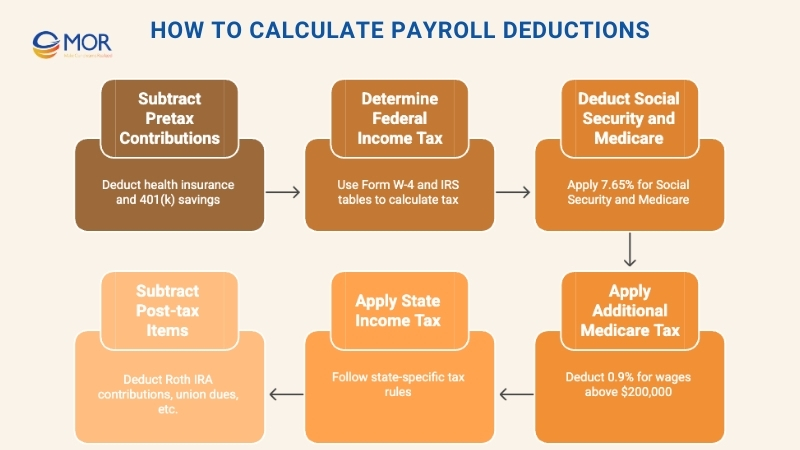
- Apply an additional 0.9% Medicare tax once earnings for the year exceed $200,000.
- For states with income tax, follow the instructions in the official state employer’s tax guide.
- Remove post-tax items like Roth IRA contributions, union dues, charitable donations, or garnishments to calculate net pay.
Employers often rely on payroll systems to automate these steps. This helps keep every payroll deduction meaning accurate and ensures compliance while reducing the chance of costly mistakes.
Simplify Your Payroll Deductions With MOR Software
For business owners, payroll deductions can be one of the most time-consuming and error-prone parts of managing a team. Tax rules change, benefits vary, and even small mistakes can lead to compliance headaches or unhappy employees.
MOR Software is one of payroll outsourcing companies that builds tailored payroll systems that automate every deduction step, from taxes to voluntary benefits. Our solutions cut down manual work, improve accuracy, and give you a clear view of payroll costs in real time.
With our expertise, you gain a reliable system that keeps your payroll deductions simple, compliant, and ready to grow with your business.
Conclusion
Knowing what are payroll deductions and how to calculate them correctly is essential for smooth payroll management. From statutory taxes to voluntary benefits, every deduction affects both compliance and employee satisfaction. Missteps can cost time, money, and trust. Ready to simplify payroll and focus on growing your business? Contact us today to see how our expertise can support you.
MOR SOFTWARE
Frequently Asked Questions (FAQs)
What is deducted from payroll?
Along with federal and state taxes like income tax and payroll taxes, employees may also see other amounts taken from their paycheck. Some of these are “pretax deductions,” which reduce taxable income. They often include retirement plan contributions and certain health care expenses.
What are the two types of deductions?
Deductions fall into two categories: standard and itemized. The standard deduction is a fixed amount based on filing status. If your deductible costs are higher than that amount, you can choose to itemize by listing each expense individually, which may reduce your taxable income more.
What is the most common deduction from your paycheck?
The most frequent payroll deductions are federal income tax, state income tax, Social Security, and Medicare. Other possible deductions include health insurance premiums, retirement contributions, and wage garnishments.
How do you record payroll deductions?
When making the journal entry, you record the total gross pay as a debit to wage expense. Then, debit payroll tax expenses and credit liability accounts for each deduction. Finally, credit the cash account for the net amount actually paid to employees.
What does it mean to deduct your salary?
A salary deduction is money taken from an employee’s gross pay before calculating net pay. These deductions can include taxes, retirement contributions, insurance premiums, and other approved expenses.
How do deductions work?
Deductions reduce your taxable income, meaning you pay tax on a smaller amount. Tax credits, on the other hand, directly lower the amount of tax you owe. Some credits are refundable, which means if they lower your tax below zero, you receive the extra as a refund.
What are the deductions allowed in income tax?
Commonly allowed deductions include life insurance premiums, contributions to PPF, repayment of home loan principal, investments in ELSS funds, and deposits into schemes like Sukanya Samriddhi Yojana. Using these deductions wisely can help reduce your tax bill under Section 80C.
What is a 100% deduction?
Expenses that are fully deductible (100%) include holiday parties, meals at open houses, and some business-essential meals. Others, like client meals or in-office meeting meals, may be only 50% deductible. Entertainment costs, such as sports tickets or club memberships, are usually not deductible at all.
Rate this article
0
over 5.0 based on 0 reviews
Your rating on this news:
Name
*Email
*Write your comment
*Send your comment
1